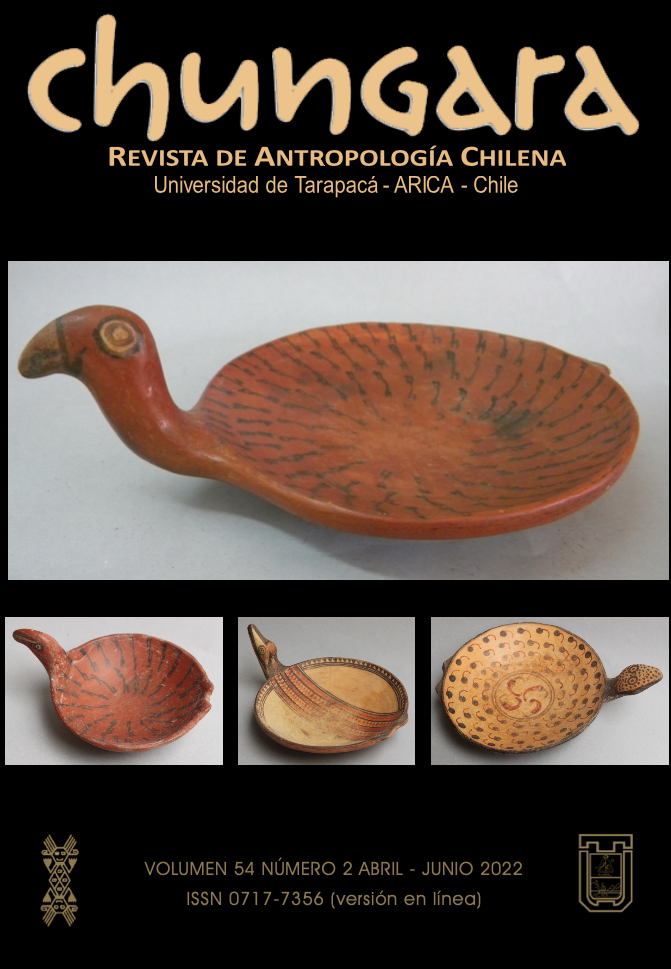Written by Super User. Posted in Papers - English
THE SETTLEMENT PREHISPANIC OF SAN LORENZO: ARCHITECTURE AND LANDSCAPE OF PERIOD MIDDLE IN THE VALLE DE AZAPA (NORTH OF CHILE)
EL ASENTAMIENTO PREHISPÁNICO DE SAN LORENZO: ARQUITECTURA Y PAISAJE DEL PERIODO MEDIO EN EL VALLE DE AZAPA (NORTE DE CHILE)
Iván Muñoz and Mabel Peña
This article discusses the archaeological site of San Lorenzo (Az-11), a pre-Hispanic human settlement of multiethnic convergence located in the lower sector of the Azapa valley and linked to the Middle (500 AD-950 AD) and Early Intermediate periods (1000 AD). The settlement of San Lorenzo was built on the hills of the same name, at the top of mounds 1 and 2 in the Las Maytas sector in the AzapaValley. The materials used for the construction of the enclosures were obtained from a series of quarries located in the vicinity of the San José river, which provided sand and gravel, and from slopes and wetlands, from which wood and canes were obtained. The study of the architecture of this site, as part of the cultural landscape of the Azapa valley, allows to analyze the function of the settlement as central in the formation of territorial identities, i.e., as a meaningful space that was part of the construction of a cultural group at a given time. The fieldwork methodology was based on prospecting the place and on spatial analysis of the site from topographic documentation, satellite pictures, surveys and architectural drawing, as well as on ethnographic background and information from previous archaeological excavations. We highlight the importance of the architecture of San Lorenzo in the context of the natural and social landscape in a valley of the coastal desert. It revises aspects of the way of life and of the social and cultural relations that modified the landscape. Archaeologically, the site corresponds to complex architecture destined to human domestic-ceremonial habitation, which eventually turned into a city that agglutinated and integrated the farmers of the valley, becoming a social and economic exchange center where interaction with other human groups from different valleys of the Andean microregion took place.
Continuar leyendo - PDF
Print
Email
Written by Super User. Posted in Papers - English
THE TARAPACÁ DECLARATION: “A WATERLESS PEOPLE IS A DEAD PEOPLE”
ACTA DE TARAPACÁ: “PUEBLO SIN AGUA, PUEBLO MUERTO”
Calogero M. Santoro, Victoria Castro, José M. Capriles, José Barraza, Jacqueline Correa, Pablo A. Marquet, Virginia McRostie, Eugenia M. Gayo, Claudio Latorre, Daniela Valenzuela, Mauricio Uribe, María Eugenia de Porras, Vivien G. Standen, Dante Angelo, Antonio Maldonado, Eva Hamamé and Daniella Jofré
“The Tarapacá Declaration” draws attention to the urgent need to change how human societies have been using water in the Atacama Desert, based on a historical trajectory spanning several millennia. The Declaration, an initiative that summarizes the results of the CONICYT/PIA, Anillo project SOC1405, is oriented towards civil society and various political entities, aiming to generate technological and cultural changes to halt and mitigate the effects caused by anthropogenic activities in one of the oldest and most arid deserts in the world. In the course of the project, we established the urgent need to sensitize society to the wasteful overuse and misuse of water in the Atacama Desert, a non-renewable resource in relation to the economic scales of extraction of this element that depends, fundamentally, on fossil waters that have accumulated for millennia in the highlands of the Desert. In this way we want to avoid that this scientific knowledge is encapsulated in the universities and to echo the point made by Victoria Castro (2003): that to grow you have to educate.
Continue reading - PDF
Print
Email






